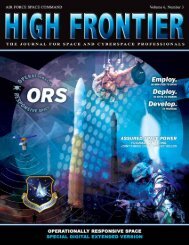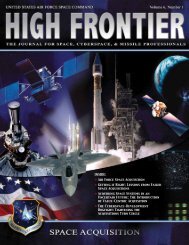Dr. Simon Ramo - Air Force Space Command
Dr. Simon Ramo - Air Force Space Command
Dr. Simon Ramo - Air Force Space Command
You also want an ePaper? Increase the reach of your titles
YUMPU automatically turns print PDFs into web optimized ePapers that Google loves.
<strong>Dr</strong>. <strong>Simon</strong> <strong>Ramo</strong><br />
Inducted 1989<br />
<strong>Dr</strong>. <strong>Simon</strong> <strong>Ramo</strong> was born in Salt Lake City, Utah, on 13 May 1913. <strong>Ramo</strong> earned a<br />
B.S. in electrical engineering at the University of Utah and, at twenty-three, a Ph.D. in<br />
electrical engineering and physics at Cal Tech. General Electric hired him immediately.<br />
At GE, he served as section head of the general engineering laboratory and head of the<br />
physics section of the electronics research laboratory. As a GE scientist he attained<br />
world recognition as a pioneer in microwave technology and developed GE's electron<br />
microscope. In 1946, unhappy about GE's diminishing prospects in high technology and<br />
eager to return to California, <strong>Ramo</strong> joined Hughes <strong>Air</strong>craft Company.<br />
At Hughes, <strong>Ramo</strong> served as the director of research in the electronics department and<br />
held the titles of Vice President, and Director of Operations. <strong>Ramo</strong> instituted hightechnology<br />
research and development at the company. Largely because of his work,<br />
Hughes received initial contracts from the <strong>Air</strong> <strong>Force</strong> for advanced military electronics<br />
and for R&D of guided-missiles.<br />
In 1953, <strong>Ramo</strong> and Dean E. Wooldridge, who was co-director of research and<br />
development laboratories at Hughes, wished to discuss possible solutions to several<br />
management problems with Howard Hughes, but Hughes avoided them. Frustrated, the<br />
two resigned from Hughes on Friday, 11 September 1953. By the following Wednesday,<br />
they had established <strong>Ramo</strong>-Wooldridge Corporation and by Friday afternoon had a<br />
contract to provide science and engineering analysis to a Defense Department strategicmissile<br />
planning effort.
The "Teapot Committee" or as it became officially known the "Strategic Missile<br />
Evaluation Committee" provided overall guidance for the USAF's ballistic missile effort.<br />
It was established by Trevor Gardner who placed both <strong>Simon</strong> <strong>Ramo</strong> and Dean E.<br />
Wooldridge on this eleven-man committee. It concluded that a beginning operational<br />
capability in long-range missiles could be attained in six years if the U.S. instituted<br />
proper management, allocated sufficient funds and the highest priority to the program,<br />
and relaxed missile performance standards. The outcome would be the <strong>Air</strong> <strong>Force</strong>'s project<br />
to develop the ballistic missile; a crash program about twice as big and complex as the<br />
Manhattan Project to develop the atomic bomb.<br />
The Western Development Division (later the Ballistic Missile Division) and <strong>Ramo</strong>-<br />
Wooldridge spearheaded the American effort. By December 1957, the two organizations<br />
were supervising over 150 first-line contracts. Observers estimated that the <strong>Air</strong> <strong>Force</strong><br />
ballistic missile program, in the late 195os, employed about 2,000 system and subsystem<br />
contractors with more than 40,000 personnel. The endeavor not only bested the Soviets in<br />
the race to set up the first operational ICBM force, but also was remarkably free of major<br />
cost overruns, schedule slippages, and waste. The ballistic missile program was one of<br />
great urgency and the highest priority.<br />
He left the ballistic missile effort in October 1958. <strong>Simon</strong> <strong>Ramo</strong>'s effective leadership in<br />
the program provided the scientific foundation and forged the essential cooperation<br />
between the <strong>Air</strong> <strong>Force</strong> and industry necessary to begin the nation's military space<br />
program. He helped the United States become the world's leader in space technology and<br />
its applications. For his role as the leading civilian in the <strong>Air</strong> <strong>Force</strong>'s ballistic missile<br />
program, the <strong>Air</strong> <strong>Force</strong> awarded him a special citation of honor.<br />
After his days in the ballistic missile program, he continued to remain active in business<br />
and serve as a key advisor to the government on science and technology. He was<br />
chairman of the President's Committee on Science and Technology under President<br />
Gerald R. Ford and was co-chairman of the Transition Task <strong>Force</strong> on Science and<br />
Technology under President Ronald Reagan. He also was a member of the White House<br />
Energy Research and Development Council, the Advisory Committee to the Secretary of<br />
State on Science and Foreign Affairs, the Advisory Council to the Secretary of<br />
Commerce, and the Roster of Consultants to the Energy Research and Development<br />
Administration. In addition, he was a consultant for the White House Office of Science<br />
and Technology Policy and a member of the Department of Defense's Advisory<br />
Committee on the Strategic Defense Initiative. He co-founded two Fortune 500<br />
companies. One of these was TRW, an enormously successful defense electronics firm<br />
that put together the complex systems required for the first American intercontinental<br />
ballistic missile, the other was Bunker-<strong>Ramo</strong>, a computer venture; Allied Corporation,<br />
now Allied Signal, acquired it in 1981. He also has served on the National Science Board.











